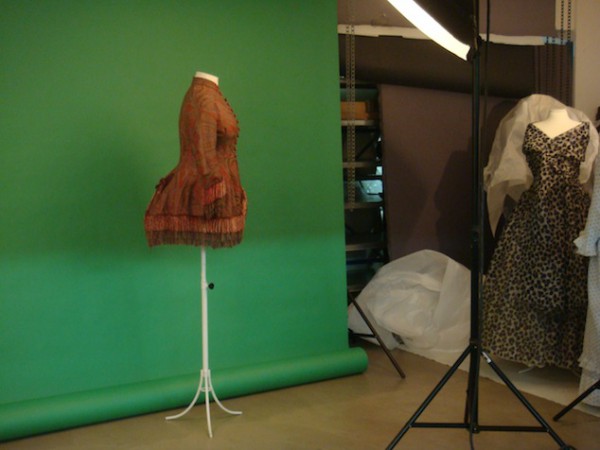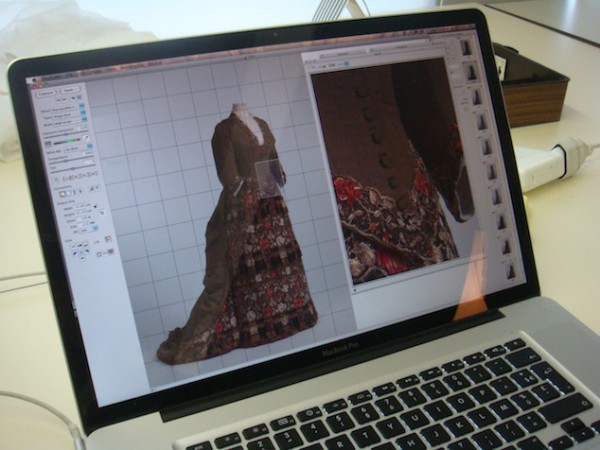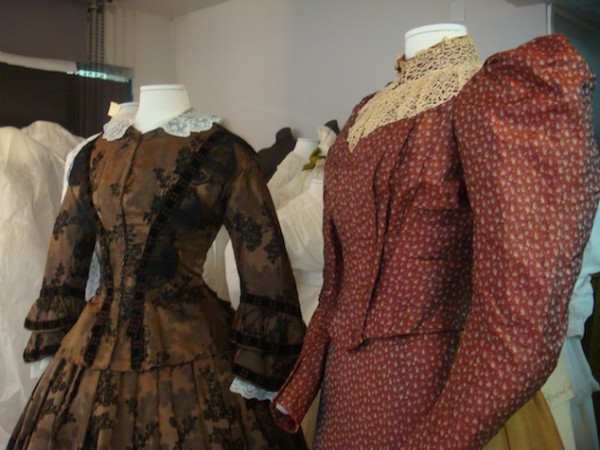 When we do a photoshoot of MoMu collection pieces for an exhibition catalogue, it nearly feels like a real fashion shoot: there’s a studio, a photographer, people who arrange the costume (a bit like stylists) and an art-director (or two). The only person missing is a model: we use mannequins instead because the clothes in our collection cannot be worn by humans, since this is too damaging for the fragile textiles.
When we do a photoshoot of MoMu collection pieces for an exhibition catalogue, it nearly feels like a real fashion shoot: there’s a studio, a photographer, people who arrange the costume (a bit like stylists) and an art-director (or two). The only person missing is a model: we use mannequins instead because the clothes in our collection cannot be worn by humans, since this is too damaging for the fragile textiles.
Historic dresses from the Jacoba de Jonge collection in line-up for the shoot, 2012 (c) MoMu
 The use of mannequins for a shoot has advantages (there’s never a bad hairday, and once a pose is good, the manneuin can stay like that for hours) but it also causes problems: the lack of limbs make the piece very static, and it is very hard to make it look expressive or life-like, it is hard to bring any natural movement into clothes. For this shoot, all the dresses have different sizes and body forms, because the silhouettes come out of such different eras, in which the female form, or how it was manipulated in fashion, changed. The corsets and crinolines are all very specific to a certain shape, hence the mannequins were all cut to fit the dress. Then they are covered and filled with extra padding, so the photoshoot took a lot of preparation for some 40+ silhouettes, and this is only half the amount of garments in the exhibition.
The use of mannequins for a shoot has advantages (there’s never a bad hairday, and once a pose is good, the manneuin can stay like that for hours) but it also causes problems: the lack of limbs make the piece very static, and it is very hard to make it look expressive or life-like, it is hard to bring any natural movement into clothes. For this shoot, all the dresses have different sizes and body forms, because the silhouettes come out of such different eras, in which the female form, or how it was manipulated in fashion, changed. The corsets and crinolines are all very specific to a certain shape, hence the mannequins were all cut to fit the dress. Then they are covered and filled with extra padding, so the photoshoot took a lot of preparation for some 40+ silhouettes, and this is only half the amount of garments in the exhibition.
Historic dresses from the Jacoba de Jonge Collection in line-up for the shoot, 2012 (c) MoMu
Historic dresses from the Jacoba de Jonge Collection in line-up for the shoot, 2012 (c) MoMu

Historic dresses from the Jacoba de Jonge Collection in line-up for the shoot, 2012 (c) MoMu
 Once the first few photos, in which the lighting has to be carefully adjusted (every crinkle and crease in the fabric seems to grow larger on camera), are done, the rythm of shots grows quicker. we have to stay very attentive to detail, however, as every silhouette is a new challenge, with interesting details but sometimes also signs of decay, that have to be camouflaged without manipulating the piece too much.
Once the first few photos, in which the lighting has to be carefully adjusted (every crinkle and crease in the fabric seems to grow larger on camera), are done, the rythm of shots grows quicker. we have to stay very attentive to detail, however, as every silhouette is a new challenge, with interesting details but sometimes also signs of decay, that have to be camouflaged without manipulating the piece too much.
The largest difference with a â€کnormal’ fashion shoot is maybe just that: the museum is no place for quickly trying out new combinations or adapting clothes, they can barely be touched.
Historic dresses from the Jacoba de Jonge Collection in line-up for the shoot, 2012 (c) MoMu
 Nevertheless, it is a very exciting challenge to make the historical silhouettes come alive on the photograph, putting the title of the exhibition â€کLiving fashion’ into practice.
Nevertheless, it is a very exciting challenge to make the historical silhouettes come alive on the photograph, putting the title of the exhibition â€کLiving fashion’ into practice.
Historic dresses from the Jacoba de Jonge Collection in line-up for the shoot, 2012 (c) MoMu






















